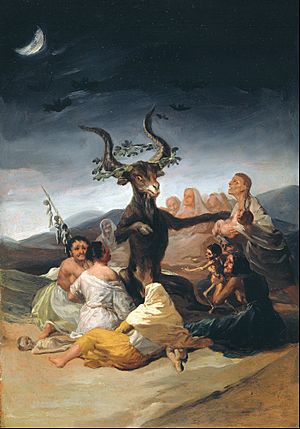Witches' Sabbath (Goya, 1798) facts for kids
Quick facts for kids Witches' Sabbath |
|
|---|---|
| Spanish: El aquelarre | |
 |
|
| Artist | Francisco Goya |
| Year | 1797–1798 |
| Medium | Oil on canvas |
| Dimensions | 43 cm × 30 cm (17 in × 12 in) |
| Location | Museo Lázaro Galdiano, Madrid |
Witches' Sabbath (Spanish: El Aquelarre) is a famous oil painting from 1798. It was created by the Spanish artist Francisco Goya. Today, you can see this painting at the Museo Lázaro Galdiano in Madrid, Spain.
The painting was bought in 1798 by the Duke and Duchess of Osuna. They also bought five other paintings about witchcraft at the same time. People believe the Duchess was the one who wanted these paintings. It's not known if she asked Goya to paint them or if she bought them after they were finished.
Much later, in the 1900s, a rich businessman named José Lázaro Galdiano bought the painting. When he passed away, he gave it to the Spanish government.
What the Painting Shows
Witches' Sabbath shows a dark and mysterious scene. In the middle, there is a large goat-like figure called Baphomet. It has big horns and a wreath of oak leaves on its head. This figure is surrounded by a group of witches. Some witches look young, while others look old.
The scene takes place in a barren landscape under the light of the moon. On the right side, an old woman holds what looks like a small, weak child. Another younger witch nearby holds a healthier child. This might suggest a dark ritual or ceremony.
In the foreground, you can see other figures and shapes. The painting uses many symbols often linked to witchcraft. For example, some symbols are shown backward or upside down. The goat extends its left hoof instead of its right. The crescent moon also faces out of the canvas in an unusual way. Bats fly overhead, and their movement matches the curve of the moon.
Goya's Other Witchcraft Paintings
Goya painted many works that showed groups of witches. One of his most famous is a much larger painting called Witches' Sabbath or The Great He-Goat. This painting was made later, between 1821 and 1823. It is part of his "Black Paintings" series.
Some people think Goya's paintings were a way to protest against the Spanish Inquisition. This was a powerful group that had hunted witches in the 1600s. In the 20th century, art experts believed Witches' Sabbath was painted during a tough time in Spain. There was a big fight between people who wanted more freedom and those who supported the church and the king. This period was known as the Ominous Decade.
Both of Goya's "Witches' Sabbath" paintings can be seen as a criticism of old superstitions. During Goya's time, many people in the countryside believed in stories about witches meeting at night and the devil appearing. Goya didn't like how people were so superstitious. He also disliked how the church seemed to encourage these old fears.
Goya's art showed these scenes even though wealthy people ordered them. Some critics say he was making fun of these old fears. He believed these fears were sometimes used by powerful groups to gain more control or money.
Images for kids
-
Witches' Flight, 1797–98. This is another painting from the set owned by the Duchess of Osuna.
See also
 In Spanish: El aquelarre (1798) para niños
In Spanish: El aquelarre (1798) para niños



